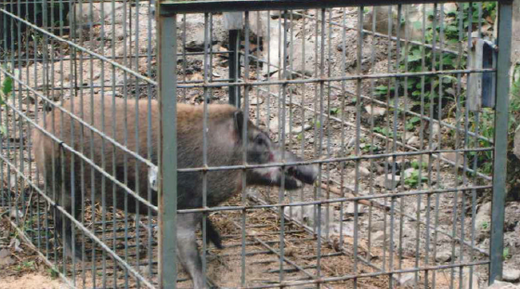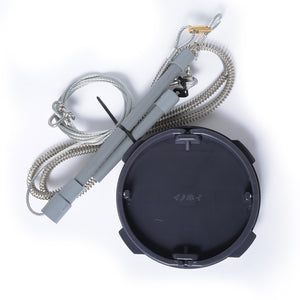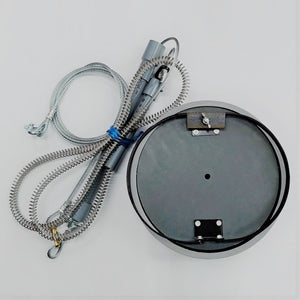"Traps" are indispensable for catching wild boars other than gun hunting.
Traps such as pitfalls have long been used in Japan to prevent wild boars from damaging crops, but in modern times some traps have become obsolete or even banned for various reasons. For example, the "torabasami" (trapping the leg of an animal), which appears in folk tales, is famous, but it is now a prohibited hunting tool.Under such circumstances, the types of traps that can currently be used to target wild boars are divided into three types: " box traps ", " tie traps " and " enclosure traps ".
We will explain the advantages and disadvantages of these traps and the procedure for capturing them. Based on the characteristics of the trap, consider the environment of the installation location, budget, labor, etc., and select an appropriate trap. Also, each trap has restrictions, so be sure to keep that in mind as well.
Wild Boar Trap #1: Box Trap
There are various sizes and shapes, but box traps are box-shaped traps that are completely surrounded by wire mesh or boards. Both attract prey to the interior of the box with bait.
When the lured prey enters the box, the trigger is activated and the entrance is closed, and the capture is completed by confining the prey. Typical trigger methods are:
◆Kicking string method: It works when the kicking string touches the body of the prey.
◆ Footboard method: Operates when the prey steps on the footboard.
◆ Rotating shaft (rotating rod) method: Operates by rotating the shaft.
Since it is difficult to adjust the position of the trigger with the treadle method and the rotating shaft method, we recommend the kick string method box trap, which allows easy adjustment of the trigger position and sensitivity (the video above shows the kick string method).
In recent years, a type that is activated by a sensor has also appeared, and the number of introductions is gradually increasing because it is devised to reduce the labor of rigging and increase the capture rate.
Advantages of box traps
In the first place, because of the structure that lures prey with bait, the catch rate is high compared to traps that do not use bait. It is also possible to capture multiple prey. In addition, from the point of view of the prey, it has an open appearance, so it tends to be more efficient than black box traps (for example, drum can traps).
Because of its instantly recognizable appearance, there is no chance of it being accidentally hooked by a human. Even if other non-target birds are captured, they can be easily released and the risk of injury is low.
And in most cases, you can assemble it yourself. From these points, it can be said that it is a kind of trap that is easy to handle even for beginners.
Disadvantages of box traps
Capable of capturing is less than large type enclosure traps. Box traps for wild boars are quite large and heavy, so even if they are disassembled, it is difficult to transport them without using a car. Therefore, it takes effort to move it, and it is difficult to install it in places other than where you can go by car.
Since many of them cost around 100,000 yen, it can be said that they are not suitable for installing many.
By the way, you can also make your own box trap. The material cost is about 20,000 yen, but you will need skills and tools for cutting and welding. If you use box traps that are weakly welded and brittle, accidents may occur, so people who are not confident in their skills should avoid making their own.
Also, the bait used for trapping may attract a lot of wild boars, so be careful where you set it up.
Another thing to keep in mind when using box traps is that it can take some time to successfully catch them. For wary boars, it's natural for them to be wary if a box trap suddenly appears in their territory. Breaking-in is required to release the vigilance and lure it into the box trap, but the period required for break-in varies depending on the individual. It may take a certain amount of time, and during that time it is necessary to continue feeding and observing the surrounding environment, so it is a good idea to assume that it will be a long-term battle in advance.
Procedure for catching with a box trap
The procedure for capturing with a box trap is as follows.
- ① Decide on a location
- (2) Attracted to place 1 by feeding
- ③ Continue to feed and release the wariness of traps
- ④ Caught in a trap
- ⑤Disposal
The most important step is feeding. Wild boars are timid and cautious, and even if you set a trap, they won't get close to you. Therefore, if you do not lure them by feeding them, they will not enter the trap, and you will not succeed in capturing them. After the trap is set up, they often do not eat the food in the trap immediately, but keep feeding them for about a week and observe the situation carefully.
In addition, it is necessary to devise the position and amount of food to be placed. Even if you suddenly put bait in the box trap, wild boars are often wary and do not approach it easily. Immediately after setting up, first sprinkle a small amount of bait around the box trap. Continue to observe and if there is evidence of eating bait, gradually reduce the amount of bait starting from the farthest position from the box trap, and gradually guide it toward the box trap. Gradually lure the boar into the box trap to keep the boar off guard. Eventually, it will guide you into the box trap and lure it to the position where the trigger will be activated.
When catching a wary boar with a box trap, it may be a protracted battle. Even if the feeding is progressing smoothly, there are cases where one day they do not appear for several weeks. If the lure is not successful, using a trail camera or the like to observe where and when the wild boars are wary will give you hints on how to improve the situation.
Boar Trap Part 2: Tie Trap
Kukuri Trap refers to a trap that tightens and restrains when a part of the prey's body enters into a ring-shaped wire called a "snare".
◆ Pull spring method: Contrary to the push spring, the coil part is set in a pulled state, and the force that tries to return is used. It also features hooks on both ends of the spring.
◆ Torsion spring method : Also called torsion spring, kick spring, or torsion coil spring. An arm (leg) is attached to the coil part, and a load is applied in the direction of winding the coil part. The "push spring type" is inexpensive and has the feature that it is not easily affected by the operation even in frozen land. The torsion spring type may malfunction if the coil freezes. Extension springs also have narrow coil spacing and may freeze, so in winter, we recommend using compression springs with play in the coil spacing. On the other hand, the disadvantages are that it takes time to properly calculate the length and structure of the wire, and that it is easily deformed by the power of prey.
The advantage of the "pull spring type" is that it is easy to carry and you don't have to dig a hole for installation. Suitable for narrow places and mud areas where it is difficult to bury traps. Disadvantages include that the installation location is limited to places with standing trees, and that there is a trick to the installation method.
The greatest advantage of the "torsion spring type" is that the power of the power is strong. Suitable for repeated use as it is durable and hard to break. As a disadvantage, it is necessary to pay attention to the fact that the price is high, it is bulky to carry due to its size and weight, and it takes labor to dig a hole.
- The diameter of the ring must be within 12cm
- Tightening prevention metal fittings* must be installed.
- Wire diameter must be 4mm or more
- Throwing back* must be attached
* Tightening prevention metal fittings are metal fittings that prevent prey from being damaged by overtightening. It refers to a metal fitting that allows the ring to be easily opened (wire lock) or a metal fitting that restricts the ring to a certain size (wire stopper), and either must be installed.
*Returning (sarkan) refers to a connecting device for connecting wires. It rotates to prevent thread twisting. In areas with high levels of agricultural and forestry damage, some restrictions may be lifted in order to increase capture pressure. If you want to know the status of regulations, please check with the prefecture where you register as a hunter.
Advantages of tying traps
The biggest advantage of tying traps is their ease of use. Its advantages are that it is small and relatively inexpensive, and that it is easy to carry because it is lightweight and can be installed in places that cannot be reached by car. Also, in the case of box traps, baiting is essential, so care must be taken to bait so as not to attract wild boars to the surrounding farmlands and villages, but in the case of tying traps, it is possible to catch them without baiting. .Disadvantages of tying traps
One of the disadvantages of kukuri traps is that they are difficult to capture because you have to read the movements of the beast and set them with pinpoint accuracy. Because it is necessary to be familiar with the behavior and habits of the prey in order to catch them with a tying trap, it can be said that this is a hunting method carried out by hunters with the know-how.
Also, since only one individual can be caught per trap, it is not possible to aim for a single blow like a box trap.
Also, be aware that if you capture other birds and animals that are not targets, you may injure them. For example, it is pointed out that Asian black bears are mistakenly captured by tying traps. Asian black bears are protected in some areas, but there have been many reports of them being caught in tying traps and being forced to pull them, causing them to lose their legs.
It is also necessary to know that the range of movement of the prey is wider in the kukuri trap compared to box traps and enclosure traps, so the risk of stopping it is high. Accidents often occur with tying traps, in which the bait is directly confronted with the prey. Specifically, it is a case of "the trap is released during the stopping stabbing and the boar rushes and injures." A little carelessness can lead to an accident, so it is important to always pay close attention.
If possible, new hunters should have a veteran who is familiar with tying traps accompany them to learn the know-how and points to note.
Procedure for capturing by tying trap
The procedure for capturing with a tying trap is as follows.- ① Decide on a location
- ②Trap setting
- ③ Capture
- ④Disposal
It is important to imagine how the wild boar behaves in order to place the tying trap in the right place. For example, wild boars avoid obstacles such as branches as much as possible when walking on the ground. Therefore, by intentionally placing a branch in front of the place where the trap is set, it is possible to guide the position where the boar puts its foot down. The point of view of "what to do if it is a wild boar?" is a very important point when setting a trap. Many veteran hunters have established their own methods and know-how based on many years of experience, so if there are such people around you, it would be a good idea to talk to them.
Wild Boar Trap 3: Enclosure Trap
Enclosure traps have the same basic structure as box traps, but those without ceilings are called enclosure traps. The perimeter except the top is surrounded by stakes and fences, and when an animal enters it, the entrance door closes. Similar to box traps, baiting lures prey inside the trap. A trap that covers more than half of the top surface is treated as a box trap.Advantages of corral traps
Similar to the box trap, the catch rate is high because the prey is lured by the bait. Also, if you have a large area, you can expect to catch a lot of prey at once depending on your ingenuity. Due to the structure, it is easy to expand the area of the trap, so it is easy to customize according to the installation location and the number of animals caught, and the large size of the trap makes it difficult to damage the prey to be captured.
There are exceptions to enclosure traps, and if the following conditions are met, it is possible to capture them without obtaining a hunting license (Be sure to check in advance with the local government department in the area where the trap will be set up.) ).
In addition, if you plan to install it in a hunting prohibited area (wildlife sanctuary, resting area, etc.), it is necessary to obtain a permit to capture harmful wildlife, so please check with the wildlife administration department of your local municipality before implementing. .
Cons of corral traps
Large ones are difficult to install and not easy to relocate. They are often used as permanent installations. The price is also generally higher than the box trap. Also, in the case of the type with a large area, it takes a lot of effort to kill the captured individuals. Due to the structure, it is necessary to choose a large and flat place, so it can be difficult to find a place to install it.
In addition, in the case of general triggers such as the kick string method, the trap will often operate even if there is only one prey in the trap. Even if you set up a wide area trap, there are many cases where you can only catch one per capture.
Excessive feeding of both corral traps and box traps can cause problems such as foul odors due to decay. There is also a fear that feeding may promote damage. Take into account the location of the trap, the type of bait, the surrounding environment and crops. In addition, let's work with the awareness of catching the prey that has been fed.summary
There are many types of traps that target boars, but it is important to choose the type that best suits your needs. First, determine your needs and then choose a trap that meets them.

 箱罠
箱罠
 くくり罠
くくり罠
 パーツ類
パーツ類
 電気柵
電気柵
 自作キット
自作キット
 防獣グッズ
防獣グッズ
 監視カメラ
監視カメラ

![[Explanation step-by-step] From catching wild boars by tying traps to catching them alive](http://inohoi.jp/cdn/shop/articles/inoshishi_1_-min_520x500_520x500_520x500_520x500_4420c9dd-b9d3-4280-ac59-33eb8c1d1501.jpg?v=1759380216&width=750)



![Fare Asahi Shiki Box Trap Big Size [Single Door]](http://inohoi.jp/cdn/shop/products/20180506_c693cd_e969a0f5-abac-49ee-8f2b-6de0f385e3fd_300x300_crop_center.progressive.jpg?v=1597991123)
![Fare Asahi Shiki Box Trap Big Size [Double Door]](http://inohoi.jp/cdn/shop/products/20180504_5c53af_300x300_crop_center.progressive.jpg?v=1597991101)
![Fare Asahishiki box trap medium size [single door] wire mesh specification](http://inohoi.jp/cdn/shop/files/main_300x300_crop_center.progressive.png.jpg?v=1720764665)
![Fare Asahi Shiki Box Trap Medium Size [Single Door] Deep Type](http://inohoi.jp/cdn/shop/files/f9d83dbb4ed93f76265b8cd23c07b474_300x300_crop_center.progressive.jpg?v=1726117508)
 box trap
box trap
 tying trap
tying trap
 enclosure trap
enclosure trap
 Prevention and avoidance goods
Prevention and avoidance goods
 electric fence
electric fence
 trap surveillance camera
trap surveillance camera
 transportation goods
transportation goods
 Trap detection sensor
Trap detection sensor
 hunting supplies
hunting supplies
 hunting books
hunting books
 Anti-bird goods
Anti-bird goods
 Agricultural materials/machinery
Agricultural materials/machinery
 boar
boar
 deer
deer
 Kyon
Kyon
 monkey
monkey
 raccoon
raccoon
 Badger
Badger
 palm civet
palm civet
 raccoon dog
raccoon dog
 nutria
nutria
 mouse or rat
mouse or rat
 Mole
Mole
 bear
bear
 pigeon
pigeon
 Crow
Crow







